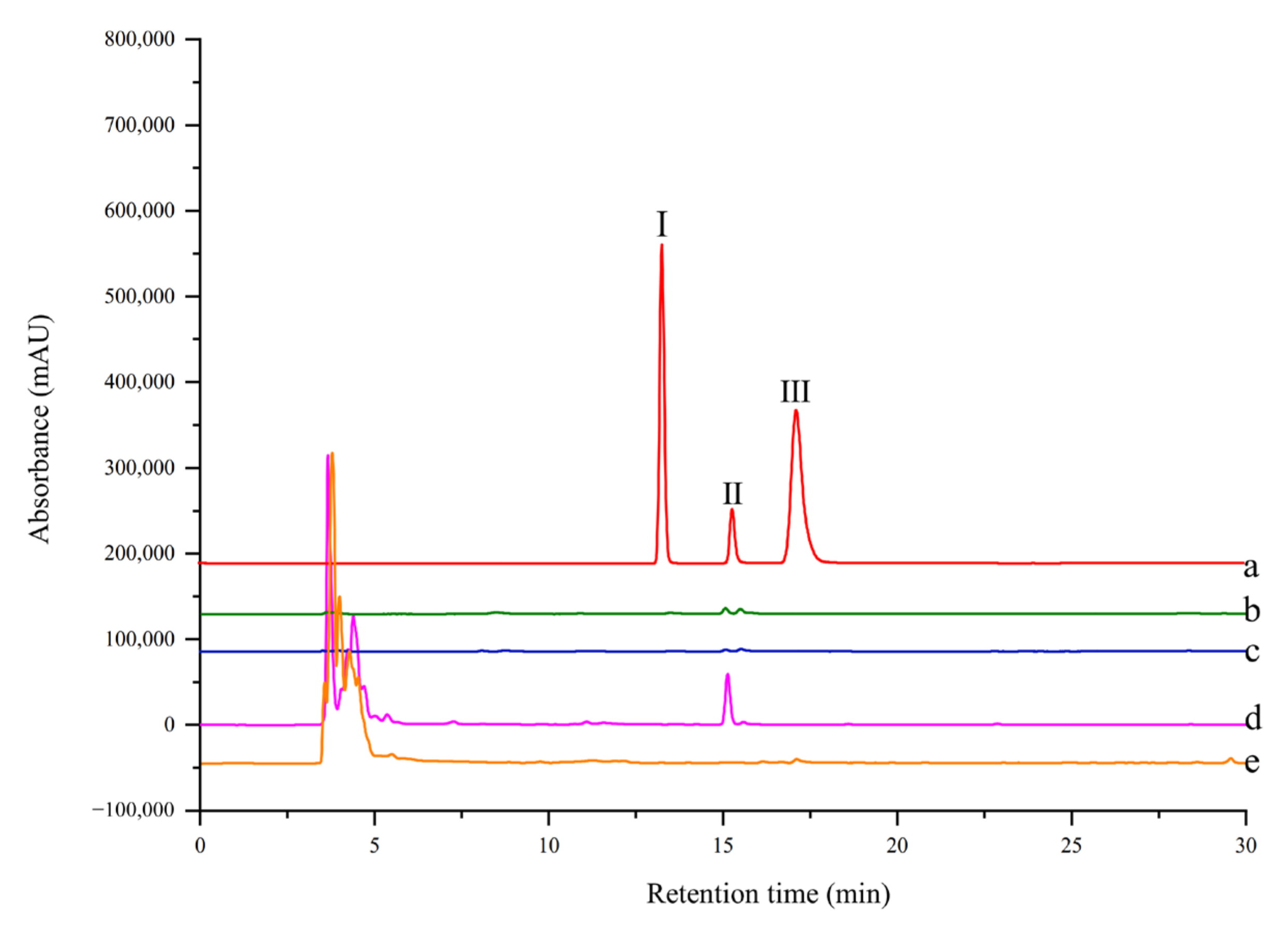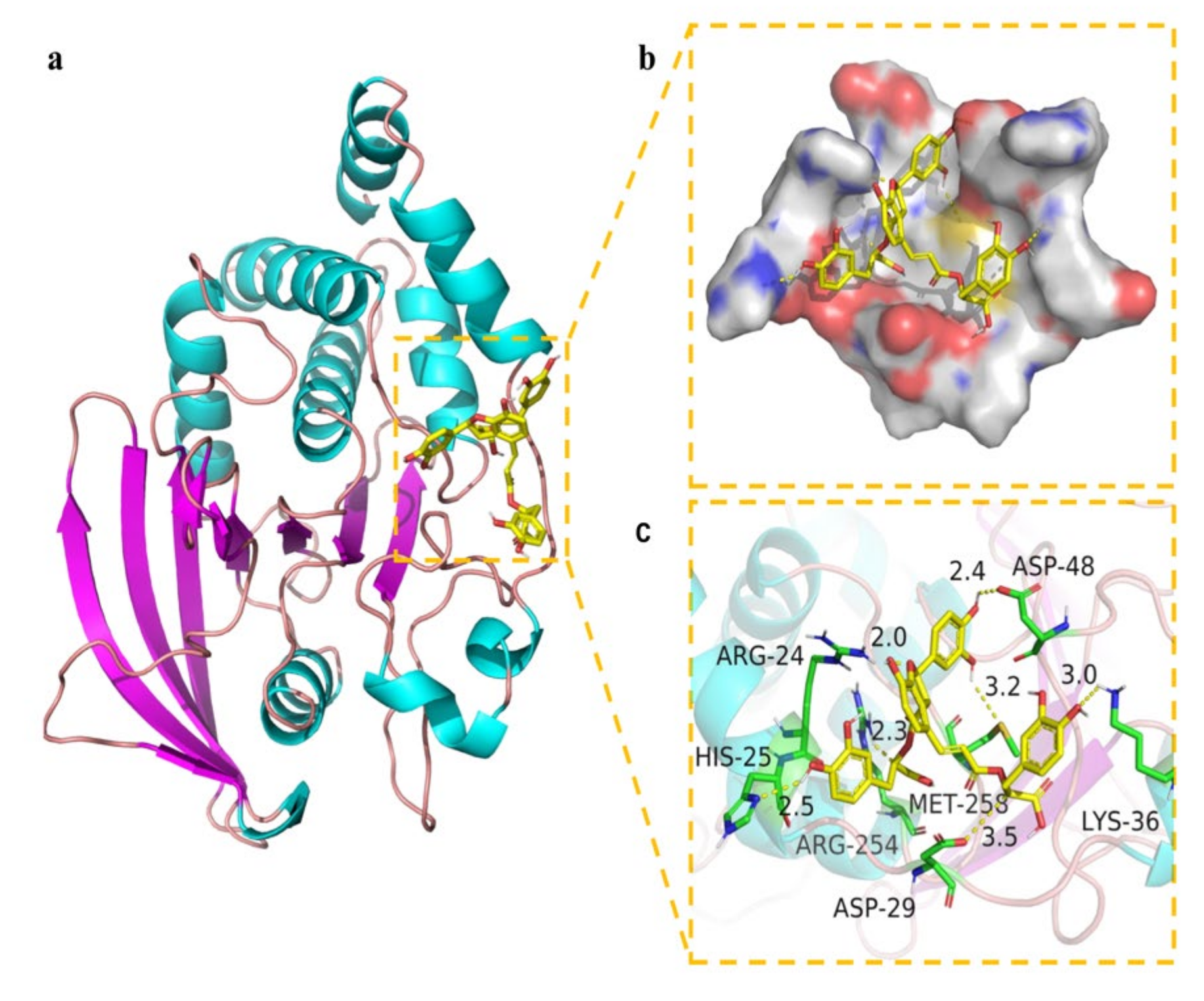Fast Screening of Protein Tyrosine Phosphatase 1B Inhibitor from Salvia miltiorrhiza Bge by Cell Display-Based Ligand Fishing
Abstract
:1. Introduction
2. Results and Discussion
2.1. Characterization of the Immobilized-PTP1Bs
2.2. Effects of pH and Temperature on the Activity of Free PTP1B, MNPs-PTP1B, and EC-PTP1B
2.3. Storage Stability of Free PTP1B, MNPs-PTP1B, and EC-PTP1B
2.4. Ligand Fishing from the Standard Mixture by MNPs-PTP1B and EC-PTP1B
2.5. Ligand Fish and Analysis of Aqueous Extract of S. miltiorrhiza
2.6. Inhibitory Mechanism of Salvianolic Acid B against PTP1B
2.7. Molecular Docking Study
3. Materials and Methods
3.1. Chemicals and Materials
3.2. Apparatus
3.3. Preparation of PTP1B Immobilized Magnetic Nanoparticles (MNPs-PTP1B)
3.4. Preparation of PTP1B Displayed Cells (EC-PTP1B)
3.5. Comparison of the Activity and Stability of the Free and Immobilized PTP1B
3.6. Validation of Ligand Fishing by MNPs-PTP1B and EC-PTP1B
3.6.1. Preparation of the Standard Mixture
3.6.2. Ligand Fishing from the Standard Mixture by MNPs-PTP1B and EC-PTP1B
3.7. Ligand Fishing of PTP1B Inhibitor from S. miltiorrhiza
3.7.1. Extraction of S. miltiorrhiza
3.7.2. Ligand Fishing by MNPs-PTP1B and EC-PTP1B
3.8. Inhibitory Assay and Kinetic Study of the Enzyme’s Ligand Salvianolic Acid B
3.9. Molecular Docking Study
4. Conclusions
Supplementary Materials
Author Contributions
Funding
Institutional Review Board Statement
Informed Consent Statement
Data Availability Statement
Conflicts of Interest
References
- Cook, W.S.; Unger, R.H. Protein tyrosine phosphatase 1B. Infect. Immun. 2002, 2, 385–387. [Google Scholar] [CrossRef] [Green Version]
- Stanford, S.M.; Aleman Muench, G.R.; Bartok, B.; Sacchetti, C.; Kiosses, W.B.; Sharma, J.; Maestre, M.F.; Bottini, M.; Mustelin, T.; Boyle, D.L. TGFβ responsive tyrosine phosphatase promotes rheumatoid synovial fibroblast invasiveness. Ann. Rheum. Dis. 2016, 75, 295–302. [Google Scholar] [CrossRef] [PubMed] [Green Version]
- St-Pierre, J.; Tremblay, M.L. Modulation of leptin resistance by protein tyrosine phosphatases. Cell Metab. 2012, 15, 292–297. [Google Scholar] [CrossRef] [PubMed] [Green Version]
- Tonks, N.K.; Muthuswamy, S.K. A brake becomes an accelerator: PTP1B-A new therapeutic target for breast cancer. Cancer Cell 2007, 11, 214–216. [Google Scholar] [CrossRef] [PubMed] [Green Version]
- Zhang, S.; Zhang, Z.Y. PTP1B as a drug target: Recent developments in PTP1B inhibitor discovery. Drug Discov. Today 2007, 12, 373–381. [Google Scholar] [CrossRef]
- Proenca, C.; Ribeiro, D.; Freitas, M.; Carvalho, F.; Fernandes, E. A comprehensive review on the antidiabetic activity of flavonoids targeting PTP1B and DPP-4: A structure-activity relationship analysis. Crit. Rev. Food Sci. Nutr. 2021, 62, 4095–4151. [Google Scholar] [CrossRef]
- Zhan, Z. Advances in biosynthesis and regulation of the active ingredient of Salvia miltiorrhiza based on multi-omics approach. Acta Pharm. Sin. 2020, 55, 2892–2903. [Google Scholar]
- Ma, R.F.; Zhu, R.Y.; Wang, L.L.; Guo, Y.B.; Liu, C.Y.; Liu, H.X.; Liu, F.W.; Li, H.J.; Li, Y.; Fu, M.; et al. Diabetic osteoporosis: A review of its traditional chinese medicinal use and clinical and preclinical research. Evid.-Based Complement. Altern. Med. 2016, 2016, 3218313. [Google Scholar] [CrossRef] [Green Version]
- Kim, D.H.; Paudel, P.; Yu, T.; Thi Men, N.; Kim, J.A.; Jung, H.A.; Yokozawa, T.; Choi, J.S. Characterization of the inhibitory activity of natural tanshinones from Salvia miltiorrhiza roots on protein tyrosine phosphatase 1B. Chem.-Biol. Interact. 2017, 278, 65–73. [Google Scholar] [CrossRef]
- Kim, Y.H.; Kim, B.Y.; Seog, A.J. Screening of the inhibitory activity of medicinal plants against protein tyrosine phosphatase 1B. Korean J. Pharmacogn. 2004, 35, 16–21. [Google Scholar]
- Zhu, Y.T.; Jia, Y.W.; Liu, Y.M.; Liang, J.; Ding, L.S.; Liao, X. Lipase ligands in Nelumbo nucifera leaves and study of their binding mechanism. J. Agric. Food Chem. 2014, 62, 10679–10686. [Google Scholar] [CrossRef] [Green Version]
- Wang, H.B.; Zhao, X.P.; Wang, S.F.; Tao, S.; Ai, N.; Wang, Y. Fabrication of enzyme-immobilized halloysite nanotubes for affinity enrichment of lipase inhibitors from complex mixtures. J. Chromatogr. A 2015, 1392, 20–27. [Google Scholar] [CrossRef] [PubMed]
- Tao, Y.; Zhang, Y.F.; Wang, Y.; Cheng, Y.Y. Hollow fiber based affinity selection combined with high performance liquid chromatography-mass spectroscopy for rapid screening lipase inhibitors from lotus leaf. Anal. Chim. Acta 2013, 785, 75–81. [Google Scholar] [CrossRef]
- Hou, X.F.; Zhou, M.Z.; Jiang, Q.; Wang, S.C.; He, L.C. A vascular smooth muscle/cell membrane chromatography-offline-gas chromatography/mass spectrometry method for recognition, separation and identification of active components from traditional Chinese medicines. J. Chromatogr. A 2009, 1216, 7081–7087. [Google Scholar] [CrossRef]
- Wen, Y.Y.; Li, J.H.; Ma, J.P.; Chen, L.X. Recent advances in enrichment techniques for trace analysis in capillary electrophoresis. Electrophoresis 2012, 33, 2933–2952. [Google Scholar] [CrossRef]
- Ji, L.Y.; Wu, J.H.; Luo, Q.; Li, X.C.; Zheng, W.; Zhai, G.J.; Wang, F.Y.; Lu, S.; Feng, Y.Q.; Liu, J.N.; et al. Quantitative mass spectrometry combined with separation and enrichment of phosphopeptides by titania coated magnetic mesoporous silica microspheres for screening of protein kinase inhibitors. Anal. Chem. 2012, 84, 2284–2291. [Google Scholar] [CrossRef] [PubMed]
- Song, H.P.; Chen, J.; Hong, J.Y.; Hao, H.; Qi, L.W.; Lu, J.; Fu, Y.; Wu, B.; Yang, H.; Li, P. A strategy for screening of high-quality enzyme inhibitors from herbal medicines based on ultrafiltration LC-MS and in silico molecular docking. Chem. Commun. 2015, 51, 1494–1497. [Google Scholar] [CrossRef]
- Mark, D.; Haeberle, S.; Roth, G.; von Stetten, F.; Zengerle, R. Microfluidic lab-on-a-chip platforms: Requirements, characteristics and applications. Chem. Soc. Rev. 2010, 39, 1153–1182. [Google Scholar] [CrossRef] [PubMed] [Green Version]
- Yuan, Y.C.; Bai, X.L.; Liu, Y.M.; Tang, X.Y.; Yuan, H.; Liao, X. Ligand fishing based on cell surface display of enzymes for inhibitor screening. Anal. Chim. Acta 2021, 1156, 338359. [Google Scholar] [CrossRef] [PubMed]
- Stano, J.; Siekel, P.; Micieta, K.; Blanarikova, V.; Korenova, M.; Bergerova, E.; Nemec, P. Identification and determination of the intra- and extracellular aminopeptidase activity by synthetic L-Ala-, L-Tyr-, and L-Phe-beta-napthylamide. Pharmazie 2008, 63, 909–912. [Google Scholar] [PubMed]
- Cui, C.; Tao, Y.F.; Li, L.L.; Chen, B.Q.; Tan, T.W. Improving the activity and stability of Yarrowia lipolytica lipase Lip2 by immobilization on polyethyleneimine-coated polyurethane foam. J. Mol. Catal. B Enzym. 2013, 91, 59–66. [Google Scholar] [CrossRef]
- Yao, Y.F.; Ding, Q.B.; Ou, L. Biosynthesis of (deoxy)guanosine-5′-triphosphate by GMP kinase and acetate kinase fixed on the surface of E. coli. Enzym. Microb. Technol. 2019, 122, 82–89. [Google Scholar] [CrossRef]
- Francisco, J.A.; Stathopoulos, C.; Warren, R.A.J.; Kilburn, D.G.; Georgiou, G. Specific adhesion and hydfrolysis of cellulose by intact Escherichia coli expressing surface anchored cellulase or cellulose binding domains. Biotechnology 1993, 11, 491–495. [Google Scholar]
- Wang, A.A.; Mulchandani, A.; Chen, W. Whole-cell immobilization using cell surface-exposed cellulose-binding domain. Biotechnol. Prog. 2001, 17, 407–411. [Google Scholar] [CrossRef]
- Wang, A.J.A.; Mulchandani, A.; Chen, W. Specific adhesion to cellulose and hydrolysis of organophosphate nerve agents by a genetically engineered Escherichia coli strain with a surface-expressed cellulose-binding domain and organophosphorus hydrolase. Appl. Environ. Microbiol. 2002, 68, 1684–1689. [Google Scholar] [CrossRef] [PubMed] [Green Version]
- Colak, U.; Gencer, N. Immobilization of paraoxonase onto chitosan and its characterization. Artif. Cells Blood Substit. Biotechnol. 2012, 40, 290–295. [Google Scholar] [CrossRef]
- Han, Y.M.; Oh, H.; Na, M.K.; Kim, B.S.; Oh, W.K.; Kim, B.Y.; Jeong, D.G.; Ryu, S.E.; Sok, D.E.; Ahn, J.S. PTP1B inhibitory effect of abietane diterpenes isolated from Salvia miltiorrhiza. Biol. Pharm. Bull. 2005, 28, 1795–1797. [Google Scholar] [CrossRef] [PubMed] [Green Version]
- Sun, Y.S.; Zhu, H.F.; Wang, J.H.; Liu, Z.B.; Bi, J.J. Isolation and purification of salvianolic acid A and salvianolic acid B from Salvia miltiorrhiza by high-speed counter-current chromatography and comparison of their antioxidant activity. J. Chromatogr. B Anal. Technol. Biomed. Life Sci. 2009, 877, 733–737. [Google Scholar] [CrossRef]
- Wu, J.Z.; Ardah, M.; Haikal, C.; Svanbergsson, A.; Diepenbroek, M.; Vaikath, N.N.; Li, W.; Wang, Z.Y.; Outeiro, T.F.; El-Agnaf, O.M.; et al. Dihydromyricetin and salvianolic acid B inhibit alpha-synuclein aggregation and enhance chaperone-mediated autophagy. Transl. Neurodegener. 2019, 8, 18. [Google Scholar] [CrossRef] [PubMed]
- Jiang, P.; Guo, Y.J.; Dang, R.L.; Yang, M.Q.; Liao, D.H.; Li, H.D.; Sun, Z.; Feng, Q.Y.; Xu, P.F. Salvianolic acid B protects against lipopolysaccharide-induced behavioral deficits and neuroinflammatory response: Involvement of autophagy and NLRP3 inflammasome. J. Neuroinflamm. 2017, 14, 239. [Google Scholar] [CrossRef] [PubMed]
- Chen, R.; Zhu, C.Q.; Xu, L.; Gu, Y.; Ren, S.J.; Bai, H.; Zhou, Q.; Liu, X.; Lu, S.F.; Bi, X.L.; et al. An injectable peptide hydrogel with excellent self-healing ability to continuously release salvianolic acid B for myocardial infarction. Biomaterials 2021, 274, 120855. [Google Scholar] [CrossRef]
- Ha, M.T.; Shrestha, S.; Tran, T.H.; Kim, J.A.; Woo, M.H.; Choi, J.S.; Min, B.S. Inhibition of PTP1B by farnesylated 2-arylbenzofurans isolated from Morus alba root bark: Unraveling the mechanism of inhibition based on in vitro and in silico studies. Arch. Pharmacal Res. 2020, 43, 961–975. [Google Scholar] [CrossRef]
- Saeed, M.; Shoaib, A.; Tasleem, M.; Alabdallah, N.M.; Alam, M.J.; El Asmar, Z.; Jamal, Q.M.S.; Bardakci, F.; Alqahtani, S.S.; Ansari, I.A.; et al. Assessment of antidiabetic activity of the shikonin by allosteric inhibition of protein-tyrosine phosphatase 1B (PTP1B) using state of art: An in silico and in vitro tactics. Molecules 2021, 26, 3996. [Google Scholar] [CrossRef] [PubMed]
- Hu, Y.; Li, J.X.; Chang, A.K.; Li, Y.N.; Tao, X.; Liu, W.B.; Wang, Z.N.; Su, W.P.; Li, Z.H.; Liang, X. Screening and tissue distribution of protein tyrosine phosphatase 1B inhibitors in mice following oral administration of Garcinia mangostana L. ethanolic extract. Food Chem. 2021, 357, 129759. [Google Scholar] [CrossRef] [PubMed]
- Sasaki, T.; Li, W.; Higai, K.; Tran Hong, Q.; Kim, Y.H.; Koike, K. Protein tyrosine phosphatase 1B inhibitory activity of lavandulyl flavonoids from roots of Sophora flavescens. Planta Med. 2014, 80, 557–560. [Google Scholar] [CrossRef]
- Banchi, L.; Fingerhuth, M.; Babej, T.; Ing, C.; Arrazola, J.M. Molecular docking with gaussian boson sampling. Sci. Adv. 2020, 6, eaax1950. [Google Scholar] [CrossRef] [PubMed]
- Chen, Z.M.; Liu, L.L.; Wu, X.D.; Yang, R.C. Synthesis of Fe3O4/P(St-AA) nanoparticles for enhancement of stability of the immobilized lipases. RSC Adv. 2016, 6, 108583–108589. [Google Scholar] [CrossRef]
- Liu, B.; Wang, D.; Huang, W.; Yu, M.; Yao, A. Fabrication of nanocomposite particles with superparamagnetic and luminescent functionalities. Mater. Res. Bull. 2008, 43, 2904–2911. [Google Scholar] [CrossRef]
- Bradford, M.M. Rapid and sensitive method for the quantitation of microgram quantities of protein utilizing the principle of protein-dye binding. Anal. Biochem. 1976, 72, 248–254. [Google Scholar] [CrossRef]
- Rajeswari, M.; Santhi, N.; Bhuvaneswari, V. Pharmacophore and virtual screening of JAK3 inhibitors. Bioinformation 2014, 10, 157–163. [Google Scholar] [CrossRef] [PubMed] [Green Version]
- Fazi, R.; Tintori, C.; Brai, A.; Botta, L.; Selvaraj, M.; Garbelli, A.; Maga, G.; Botta, M. Homology model-based virtual screening for the identification of human helicase DDX3 inhibitors. J. Chem. Inf. Model. 2015, 55, 2443–2454. [Google Scholar] [CrossRef] [PubMed]








Publisher’s Note: MDPI stays neutral with regard to jurisdictional claims in published maps and institutional affiliations. |
© 2022 by the authors. Licensee MDPI, Basel, Switzerland. This article is an open access article distributed under the terms and conditions of the Creative Commons Attribution (CC BY) license (https://creativecommons.org/licenses/by/4.0/).
Share and Cite
Bai, X.; Fan, W.; Luo, Y.; Liu, Y.; Zhang, Y.; Liao, X. Fast Screening of Protein Tyrosine Phosphatase 1B Inhibitor from Salvia miltiorrhiza Bge by Cell Display-Based Ligand Fishing. Molecules 2022, 27, 7896. https://doi.org/10.3390/molecules27227896
Bai X, Fan W, Luo Y, Liu Y, Zhang Y, Liao X. Fast Screening of Protein Tyrosine Phosphatase 1B Inhibitor from Salvia miltiorrhiza Bge by Cell Display-Based Ligand Fishing. Molecules. 2022; 27(22):7896. https://doi.org/10.3390/molecules27227896
Chicago/Turabian StyleBai, Xiaolin, Wenqin Fan, Yingjie Luo, Yipei Liu, Yongmei Zhang, and Xun Liao. 2022. "Fast Screening of Protein Tyrosine Phosphatase 1B Inhibitor from Salvia miltiorrhiza Bge by Cell Display-Based Ligand Fishing" Molecules 27, no. 22: 7896. https://doi.org/10.3390/molecules27227896
APA StyleBai, X., Fan, W., Luo, Y., Liu, Y., Zhang, Y., & Liao, X. (2022). Fast Screening of Protein Tyrosine Phosphatase 1B Inhibitor from Salvia miltiorrhiza Bge by Cell Display-Based Ligand Fishing. Molecules, 27(22), 7896. https://doi.org/10.3390/molecules27227896






